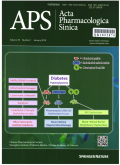- 钛学术文献服务平台 \
- 学术期刊 \
- 医药卫生期刊 \
- 药学期刊 \
- 中国药理学报(英文版)期刊 \
烷基9-氮硝基喜树碱酯类的构效关系
烷基9-氮硝基喜树碱酯类的构效关系
基本信息来源于合作网站,原文需代理用户跳转至来源网站获取
摘要:
AIM:To study the structure-activity relationship of alkyl 9-nitrocamptothecin esters. METHODS: Two alkyl9-nitrocamptothecin (9NC) esters 5g and 5h were prepared by esterification reactions of 9NC with valeric anhy-dride and heptanoic anhydride, respectively. Eight 9NC esters 5a-5h were tested for cytotoxicity against humanleukemia cell lines HL-60 and U-937. Flow cytometry analysis was used to identify the cell cycle phase targeted bythe esters and quantify the extent of ester-induced cell death (apoptosis). RESULTS: Esters 5b and 5c demonstratedgreat abilities to inhibit growth of the leukemia cells followed by induction of apoptosis; esters 5a, 5e, and 5ginduced slight perturbations in the cell cycle at high concentrations; and esters 5d, 5f, and 5h were completelyinactive against the cell lines tested. Thus these esters showed the cell anti-proliferative activity in an order of5b≈5c>5a≈5e≈5g>5d≈5f≈5h. Esters 5b, 5c, and 5e were tested in vivo against various human carcinomas in nudemice grown as xenografts. Only 5b and 5c showed a significant antitumor activity. Particularly, ester 5b demon-strated an antitumor activity agalnst a broad spectrum of human carcinomas including breast, lung, colon, pancreas,stomach, ovarian, and melanoma, etc. CONCLUSION: These esters act like prodrugs of their parental9-nitrocamptothecin. High drug doses need to be administered to animals in order to inhibit growth, and induceregression, of human tumor xenografts in nude mice. These compounds may be developed into potent anticancerdrugs due to their low toxicity.

推荐文章
9-硝基喜树碱酯类衍生物的合成和结构表征
9-硝基喜树碱
酯类衍生物
亲核取代反应
20(S)-9-硝基喜树碱的制备研究
喜树碱
硝化工艺
9-硝基喜树碱犬体内药代动力学研究
9-硝基喜树碱
药代动力学
犬
高效液相色谱
液相-质谱联用
喜树碱衍生物的合成研究进展
喜树碱
喜树碱衍生物
合成
抗癌活性
综述
内容分析
关键词云
关键词热度
相关文献总数
(/次)
(/年)
文献信息
| 篇名 | 烷基9-氮硝基喜树碱酯类的构效关系 | ||
| 来源期刊 | 中国药理学报(英文版) | 学科 | 医学 |
| 关键词 | 喜树碱 酯类 药物前体 抗肿瘤药 毒性 构效关系 | ||
| 年,卷(期) | 2003,(2) | 所属期刊栏目 | 研究原著 |
| 研究方向 | 页码范围 | 109-119 | |
| 页数 | 11页 | 分类号 | R28 |
| 字数 | 语种 | 英文 | |
| DOI | |||
五维指标
引文网络
引文网络
二级参考文献 (2)
共引文献 (2)
参考文献 (5)
节点文献
引证文献 (0)
同被引文献 (0)
二级引证文献 (0)
1985(1)
- 参考文献(1)
- 二级参考文献(0)
1989(1)
- 参考文献(1)
- 二级参考文献(0)
1992(1)
- 参考文献(1)
- 二级参考文献(0)
1996(1)
- 参考文献(1)
- 二级参考文献(0)
2000(1)
- 参考文献(0)
- 二级参考文献(1)
2003(1)
- 参考文献(0)
- 二级参考文献(1)
2008(1)
- 参考文献(1)
- 二级参考文献(0)
2003(1)
- 参考文献(0)
- 二级参考文献(1)
- 引证文献(0)
- 二级引证文献(0)
研究主题发展历程
节点文献
喜树碱
酯类
药物前体
抗肿瘤药
毒性
构效关系
研究起点
研究来源
研究分支
研究去脉
引文网络交叉学科
相关学者/机构
期刊影响力
中国药理学报(英文版)
主办单位:
中国药理学会和中科院上海药物研究所
出版周期:
月刊
ISSN:
1671-4083
CN:
31-1347/R
开本:
大16开
出版地:
上海市太原路294号
邮发代号:
4-295
创刊时间:
1980
语种:
eng
出版文献量(篇)
4416
总下载数(次)
2
总被引数(次)
42236
期刊文献
相关文献
推荐文献
- 期刊分类
- 期刊(年)
- 期刊(期)
- 期刊推荐
中国药理学报(英文版)2022
中国药理学报(英文版)2021
中国药理学报(英文版)2020
中国药理学报(英文版)2019
中国药理学报(英文版)2018
中国药理学报(英文版)2017
中国药理学报(英文版)2016
中国药理学报(英文版)2015
中国药理学报(英文版)2014
中国药理学报(英文版)2013
中国药理学报(英文版)2012
中国药理学报(英文版)2011
中国药理学报(英文版)2010
中国药理学报(英文版)2009
中国药理学报(英文版)2008
中国药理学报(英文版)2007
中国药理学报(英文版)2006
中国药理学报(英文版)2005
中国药理学报(英文版)2004
中国药理学报(英文版)2003
中国药理学报(英文版)2002
中国药理学报(英文版)2001
中国药理学报(英文版)2000
中国药理学报(英文版)1999
中国药理学报(英文版)1998
中国药理学报(英文版)2003年第9期
中国药理学报(英文版)2003年第8期
中国药理学报(英文版)2003年第7期
中国药理学报(英文版)2003年第6期
中国药理学报(英文版)2003年第5期
中国药理学报(英文版)2003年第4期
中国药理学报(英文版)2003年第3期
中国药理学报(英文版)2003年第2期
中国药理学报(英文版)2003年第12期
中国药理学报(英文版)2003年第11期
中国药理学报(英文版)2003年第10期
中国药理学报(英文版)2003年第1期

 免费查重
免费查重










